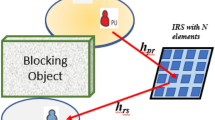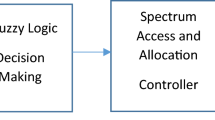Abstract
Resource allocation under spectrum sensing based dynamic spectrum sharing strategy is a critically important issue for cognitive radio networks (CRNs), because they need to not only satisfy the interference constraint caused to the primary users (PUs), but also meet the quality-of-service (QoS) requirements for the secondary users (SUs). In this paper, we develop the optimal spectrum sensing based resource allocation scheme for the delay QoS constrained CRNs. Specifically, we aim at maximizing the maximum constant arrival rate of the SU that can be supported by the time-varying service process subject to the given statistical delay QoS constraint. In our derived power allocation scheme, not only the average transmit and interference power constraints are considered, but also the impact of the PUs’ transmission to the CRNs and the PUs’ spectrum-occupancy probability are taken into consideration. Moreover, the spectrum sensing errors are also taken into consideration. Simulation results show that, (1) the effective capacity of the secondary link decreases when the statistical delay QoS constraint becomes stringent; (2) given the QoS constraint, the effective capacity of the secondary link varies with the interference power constraint and the SNR of the primary link.





Similar content being viewed by others
References
Mitola J, Maguire GQ (1999) Cognitive radio: making software radios more personal. IEEE Pers Commun 6(4):13–18
Haykin S (2005) Cognitive radio: brain-empowered wireless communications. IEEE J Sel Areas Commun 23(2):201–220
Khoshkholgh MG, Navaie K, Yanikomeroglu H (2010) Access strategies for spectrum sharing in fading environment: overlay, underlay, and mixed. IEEE Trans Mob Comput 9(12):1780–1793
Gastpar M (2007) On capacity under receive and spatial spectrum-sharing constraints. IEEE Trans Inf Theory 53(2):471–487
Ghasemi A, Sousa ES (2007) Fundamental limits of spectrum-sharing in fading environments. IEEE Trans Wirel Commun 6(2):649–658
Musavian L, Aissa S (2009) Capacity and Power allocation for spectrum-sharing communications in fading channels. IEEE Trans Wirel Commun 8(1):148–156
Kang X, Liang Y, Nallanathan A, Garg H, Zhang R (2009) Optinal power allocation for fading channels in cognitive networks: ergodic capacity and outage capacity. IEEE Trans Wirel Commun 8(2):940–950
Zhang R, Cui S, Liang Y (2009) On ergodic sum capacity of fading cognitive multiple-access and broadcast channels. IEEE Trans Inf Theory 55(11):5161–5178
Kang X, Zhang R, Liang Y, Garg HK (2011) Optimal power allocation strategies for fading cognitive radio channels with primary user outage constraint. IEEE J Sel Areas Commun 29(2):374–383
Gong X, Vorobyov SA, Tellambura C (2011) Optimal bandwidth and power allocation for sum ergodic capacity under fading channels in cognitive radio networks. IEEE Trans Signal Process 59(4):1814–1826
Musavian L, Aissa S (2009) Fundamental capacity limits of cognitive radio in fading environments with imperfect channel information. IEEE Trans Wirel Commun 57(11):3472–3480
Kang X, Liang Y, Garg HK, Zhang HK (2009) Sensing-based spectrum sharing in cognitive radio networks. IEEE Trans Veh Technol 58(8):4649–4654
Stotas S, Nallanathan A (2011) Optimal sensing time and power allocation in multiband cognitive radio networks. IEEE Trans Commun 59(1):226–235
Stotas S, Nallanathan A (2011) Enhancing the capacity of spectrum sharing cognitive radio networks. IEEE Trans Veh Technol 60(8):3768–3779
Coldsmith AJ, Chua S (1997) Variable-rate variable-power MQAM for fading channels. IEEE Trans Inf Theory 43(6):1986–1992
Chang C (1994) Stability, queue length, and delay of deterministic and stochastic queueing neyworks. IEEE Trans Automat Contr 39(5):913–931
Wu D, Negi R (2003) Effective capacity: a wireless link model for support of Quality of Service. IEEE Trans Wirel Commun 2(4):630–643
Tang J, Zhang X (2007) Quality-fo-Service driven power and rate adaptation over wireless links. IEEE Trans Wirel Commun 6(8):3058–3068
Musavian L, Aissa S (2010) Effective capacity of delay-constrained cognitive radio in nakagami fading channels. IEEE Trans Wirel Commun 9(3):1054–1062
Ma Y, Zhang H, Yuan D, Chen H (2009) Adaptive power allocation with quality-of-service guarantee in cognitive radio networls. Comput Commun 32(18):1975–1982
Akin S, Gursoy MG (2010) Effective capacity analysis of cognitibe radio channels for Quality of Service provisioning. IEEE Trans Wirel Commun 9(11):3354–3364
Liang Y, Zeng Y, Peh ECY, Hong AT (2008) Sensing-throughput tradeoff for cognitive radio networks. IEEE Trans Wirel Commun 7(4):1326–1337
Boyd S, Vandenberghe L (2004) Convex optimization. Cambridge University Press
Acknowledgements
The research reported in this article was supported in part by the National Natural Science Foundation of China under Grant No. 61172091, the National Science and Technology Major Project under Grant No. 2010ZX03005-003, the Specialized Research Fund for the Doctoral Program of Higher Education under Grant No. 20110201120014, and the National Hi- Tech Research and Development Program of China (863) under Grant No. 2011AA01A105.
Author information
Authors and Affiliations
Corresponding author
Rights and permissions
About this article
Cite this article
Wang, Y., Ren, P., Du, Q. et al. Optimal Resource Allocation for Spectrum Sensing Based Cognitive Radio Networks with Statistical QoS Guarantees. Mobile Netw Appl 17, 711–720 (2012). https://doi.org/10.1007/s11036-012-0388-9
Published:
Issue Date:
DOI: https://doi.org/10.1007/s11036-012-0388-9




